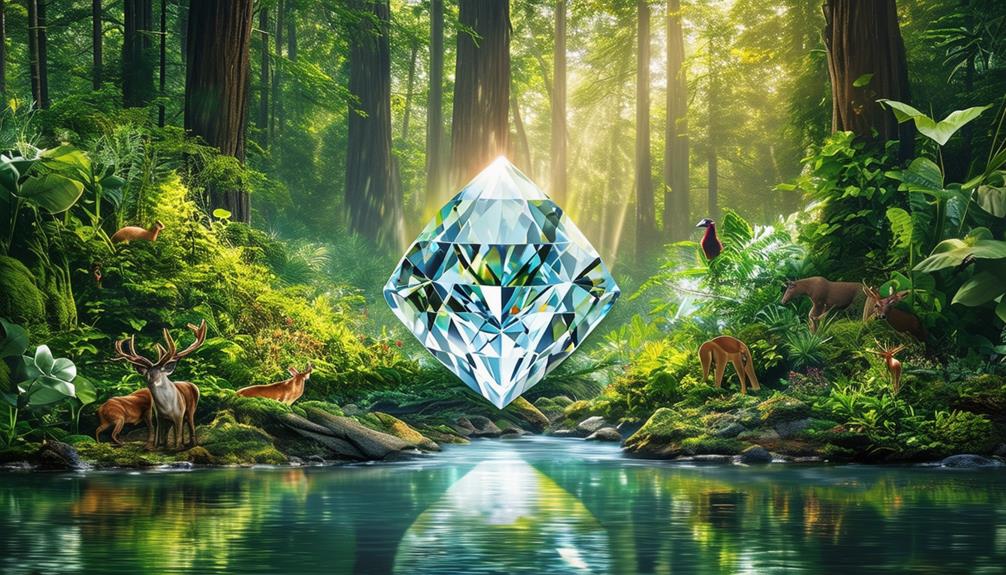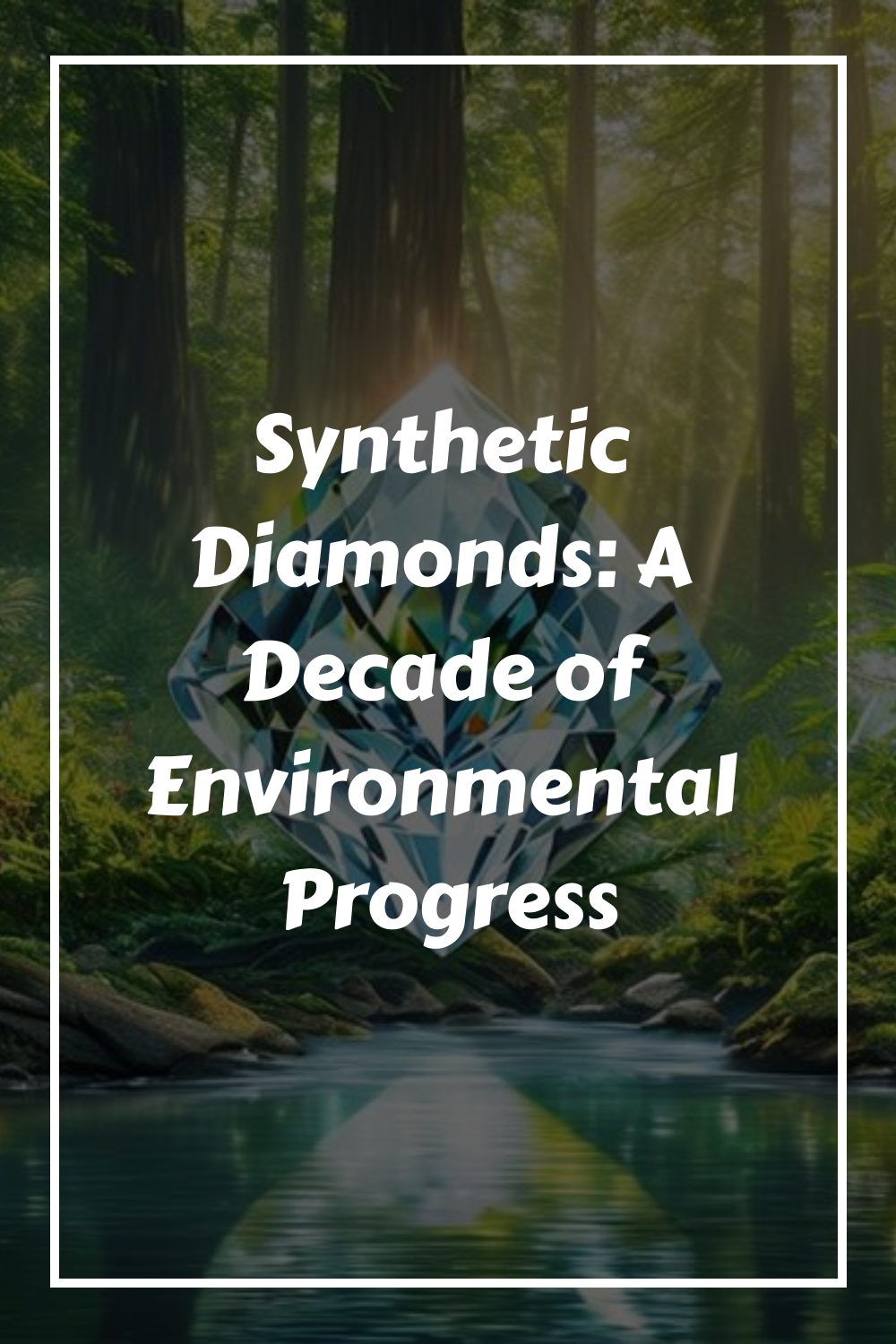Article Contents
Over the last decade, synthetic diamonds have seen significant environmental advancements. The adoption of Chemical Vapor Deposition (CVD) technology has enhanced both the scalability and quality of these diamonds while significantly reducing their environmental impact.
Compared to traditional mining, synthetic diamonds produce up to seven times less carbon dioxide—equivalent to the emissions from driving 42 miles to create a one-carat diamond. Additionally, advanced water recycling and treatment technologies have optimised resource conservation.
The industry's increasing use of renewable energy and improved recycling processes further demonstrate a commitment to sustainable practices. These developments indicate a strong, ongoing commitment to reducing environmental impact within the luxury sector, reflecting both innovation and a dedication to ecological responsibility.
Key Points
- Chemical Vapour Deposition (CVD) technology enhances the scalability and quality control of synthetic diamonds, fostering the growth of environmentally friendly luxury products.
- Synthetic diamonds produce significantly fewer carbon emissions compared to traditional mining, thereby minimising their ecological footprint.
- Innovative water recycling methods in synthetic diamond production facilities can conserve up to 90% of water, significantly reducing waste.
- Transitioning from earth-mined to lab-created diamonds contributes to the conservation of natural ecosystems and the protection of biodiversity.
- The implementation of recycling techniques for synthetic diamonds promotes resource efficiency and bolsters a circular economy model.
Evolution of Production Techniques
The development of synthetic diamond production techniques, particularly the shift from High Pressure High Temperature (HPHT) to Chemical Vapor Deposition (CVD), is a significant technological advancement with important environmental benefits. Initially, HPHT was the standard method, mimicking the natural conditions under which diamonds are formed, involving intense pressure and heat. Although effective, this approach was not ideal for large-scale production or detailed quality control.
The adoption of CVD technology has revolutionised the industry, offering a more controlled and efficient way to produce synthetic diamonds. This method allows for precise management of the diamond growth process, enhancing the scalability and consistency of the diamonds while reducing resource wastage. It enables the creation of diamonds that are tailored to specific requirements in terms of size, shape, and quality.
These technological enhancements showcase a dedication to innovation and ethical considerations, aligning with the growing consumer interest in sustainably sourced and environmentally conscious luxury products. The transition to CVD technology is part of a wider trend towards embracing methods that provide greater flexibility and responsibility in production, better meeting the diverse needs of consumers.
Reduction in Carbon Footprint
Lab-grown diamonds significantly reduce environmental impact, emitting up to seven times less carbon dioxide per carat compared to mined diamonds. This reduction not only demonstrates technological progress but also supports sustainable luxury practices. Producing a single 1-carat lab-grown diamond requires energy equivalent to driving approximately 42 miles, highlighting the progress in reducing environmental footprints.
Furthermore, manufacturers are increasingly using renewable energy sources such as solar and wind power in their production processes. This transition reduces dependence on fossil fuels and promotes a sustainable future. Carbon offset initiatives further bolster these efforts by offsetting any remaining emissions through investments in environmental restoration projects.
Water Conservation Efforts
In its commitment to environmental sustainability, the synthetic diamond industry has significantly reduced its water usage by implementing state-of-the-art water treatment technologies and closed-loop water systems. These methods allow for up to a 90% reduction in water consumption compared to traditional diamond mining. The industry's recycling processes ensure that water is reused efficiently, minimising waste and environmental impact.
- Water Recycling Systems: Sophisticated processes enable the reuse of up to 90% of water, drastically lowering the ecological impact compared to conventional mining.
- Advanced Water Treatment Technologies: These systems optimise water use, ensuring minimal waste and maximum conservation of this vital resource.
- Closed-loop Water Systems: By circulating water within the production process, these systems safeguard the environment and support sustainable manufacturing.
These initiatives are crucial in reducing the per-carat water footprint in synthetic diamond production, underscoring the industry's dedication to responsible environmental management. This approach not only meets the growing consumer demand for sustainable luxury but also positions the industry as a leader in ecological stewardship within the luxury sector.
Impact on Land and Biodiversity
Traditional diamond mining significantly disrupts ecosystems and alters habitats, with profound negative impacts on land and biodiversity. The methods used, such as deforestation and soil erosion, extensively damage the natural environment, leading to considerable habitat destruction that severely affects local wildlife populations. Open-cast mining, in particular, results in large barren areas, disrupting ecosystem continuity and reducing habitats vital for many species.
In contrast, the introduction of lab-grown diamonds represents a shift towards more sustainable practices that focus on environmental conservation. These synthetic diamonds substantially lessen the need for invasive land use, aiding in the preservation of critical habitats. By reducing ecological footprints, lab-grown diamonds support wildlife conservation and habitat restoration, minimising impacts on biodiversity and protecting ecosystems for the future.
This shift is not only a technological advancement but also reflects an increasing awareness of responsible resource management. Adopting lab-grown diamonds is a step towards ethical consumption in the luxury goods sector, promoting environmental preservation and biodiversity protection.
Advances in Recycling Processes
Advances in recycling processes for synthetic diamonds have significantly enhanced sustainability within the industry. These developments, particularly through the use of chemical vapour deposition (CVD) technology, enable the breakdown of used synthetic diamonds back into their elemental carbon state. This process not only conserves valuable resources but also aligns with the principles of a circular economy, promoting the continual reuse of materials in production cycles.
Key benefits of these advances include:
- Reduction in Waste: Recycling synthetic diamonds reduces the industry's environmental impact by preventing the disposal of valuable diamond material.
- Efficient Resource Use: Advanced technologies support the efficient repurposing of diamond materials, ensuring that each carbon atom is effectively reused in new diamond production.
- Promotion of Circular Economy: Reintegrating recycled diamonds into production cycles promotes resource sustainability, contributing to a globally recognised aim of a waste-free industry.
These technological improvements in recycling synthetic diamonds demonstrate a firm commitment to environmental responsibility and resource sustainability, setting a benchmark for the synthetic diamond industry and others to emulate.
Frequently Asked Questions
Are Synthetic Diamonds Better for the Environment?
Synthetic diamonds significantly reduce environmental impact by using fewer natural resources and emitting lower carbon compared to traditional diamond mining. They provide a more sustainable option, appealing to environmentally aware consumers.
What is the future of synthetic diamonds?
The future looks promising for lab-grown diamonds, thanks to ongoing technological progress and a growing market. These developments are improving choices for consumers, especially for those who value ethical and sustainable options in the gemstone sector.
What Are the Negative Impacts of Using Synthetic Diamonds?
The production of synthetic diamonds in the UK has significant environmental drawbacks. It requires a large amount of energy and involves the use of strong chemicals, leading to higher carbon emissions and potential pollution. This increased pressure on resources can negatively impact ecosystems and local communities.
Why Are Synthetic Diamonds Not as Valuable?
Synthetic diamonds generally have a lower market value compared to natural diamonds, mainly because of the belief in their rarity and the sentimental value attached to natural gems. Although they share similar physical and chemical characteristics, synthetic diamonds are less desirable as they are more readily available and do not have the historical charm of diamonds mined from the earth.
Conclusion
Over the past ten years, lab-grown diamonds have experienced a notable change, resembling the journey from a rough stone to a refined gem. Improved manufacturing methods have greatly lessened their environmental footprint.
The dedication to sustainability is also shown through advancements in water preservation and protecting land. With the progression of recycling technologies, lab-grown diamonds showcase both technological advancement and environmental accountability, signifying a forward-thinking change in the gemstone sector.



